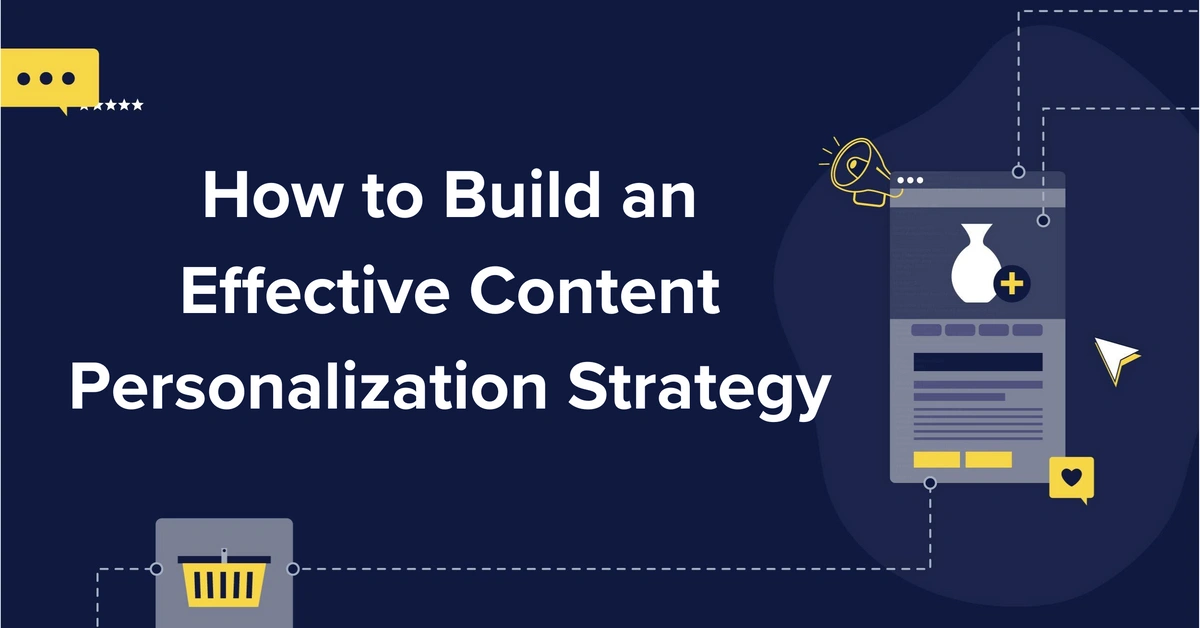
Content Strategy
How to Build an Effective Content Personalization Strategy
Posted by Bonnie Thompson on June 3, 2025
Part 1 of this series asked What is content personalization, and why is it important for today’s consumers? We looked at how top brands use content personalization to build trust, remove friction, and create experiences that keep customers coming back.
But understanding content personalization is just the first step. The real challenge is executing it. How do you go from a great idea to a scalable strategy that delivers real results? How do you personalize content in a way that feels natural and not forced? What are ways to boost your content personalization strategy? And how do you ensure your approach matches customer expectations and business goals? You need to create an effective content personalization strategy.
In this post, we’ll cover:
-
How to build a structured, data-driven content personalization strategy that aligns with business goals
-
Overcoming common obstacles that often derail content personalization efforts
-
Applying content personalization in the real world with a brand case study
By the end, you’ll have a clear, actionable plan for delivering personalised experiences that captivate, convert, and keep customers coming back.
Let’s get started.
How to create a content personalization strategy
To personalize content, you need to collect meaningful data, analyze it strategically, and deliver targeted content at scale that feels natural, not forced. Here’s how:
Step 1: Collect customer data
Content personalization starts with understanding your audience. Collect data from multiple sources to build a full customer profile. Key data sources include:
-
Behavioral data: Website visits, clicks, product views, etc.
-
Demographic data: Age, location, job title, etc.
-
Transactional data: Purchase history, abandoned carts, etc.
-
Engagement data: Email opens, social media interactions, etc.
Use a Customer Data Platform (CDP) or integrate data from your website, CRM, analytics tools, and marketing automation software to create a single source of truth about your audience.
Step 2: Analyze and segment your audience
Segmentation enables more precise messaging and tailored experiences that feel natural, not generic. After collecting the data, use behavioral, demographic, and transactional insights to create meaningful customer segments.
AI and machine learning can help analyze large datasets, predict customer behavior, and categorize users into key groups, like first-time visitors, repeat customers, or high-value loyal buyers. By refining these segments, brands can deliver more relevant, personalized experiences that drive engagement and conversions.
Step 3: Define your content personalization goals
Before you start, clarify what you want to achieve so everything you do lines up with your business objectives. Are you:
-
Increasing conversions? Personalize product recommendations and CTAs.
-
Improve engagement? Deliver dynamic, behavior-based content.
-
Reduce churn? Use predictive analytics to re-engage at-risk customers.
Clear objectives will guide your strategy and measurement. Without focus, content personalization can feel scattered or superficial, but a well-defined approach means every interaction is purposeful, relevant, and drives measurable results.
Step 4: Deliver personalized content at scale
Use automation to provide dynamic, relevant content, recommendations, and offers across channels, such as:
-
Websites: Dynamic homepages and product recommendations
-
Email: Automated, behavior-triggered campaigns
-
Social and ads: Retargeting campaigns based on browsing history
AI-driven content personalization goes even further, making sure each interaction is tailored to customer needs and preferences.
Step 5: Continuously optimize for better results
Content personalization isn’t static. Monitor performance metrics, run A/B tests, and refine your approach based on real-time feedback. The more you learn about your audience, the better you can personalize experiences that resonate and convert.
By following this structured approach, brands can scale content personalization efficiently and ensure every touchpoint is relevant, engaging, and valuable.
How developers can implement personalization at scale
For developers, content personalization means building an adaptable and scalable system. Here’s how to do it:
-
Use a headless CMS. Enables API-driven personalization, dynamically delivering content across multiple platforms.
-
Leverage AI and machine learning (ML). Machine learning algorithms analyze behavioral data to deliver real-time, hyper-personalized content.
-
Optimize for performance. Over-personalization can slow site performance. Use caching and CDNs to balance speed and personalization.
-
Prioritize privacy-first strategies. Ensure compliance with GDPR and CCPA by using first-party data ethically.
Now that you know how to implement a content personalization strategy, let’s look at a brand executing it at the highest level.
Sephora: The gold standard of content personalization
By combining AI, predictive analytics, and deep customer insights, Sephora creates a frictionless, omnichannel shopping experience, setting the gold standard for eCommerce personalization. Let’s take a closer look.
1. Intelligent discovery and attraction
Sephora personalizes marketing campaigns using AI-driven predictive analytics to target customers with ads and emails based on past behavior and beauty profile data. When visitors land on their website or app, they’re greeted with a homepage experience dynamically curated to their browsing history, purchase patterns, and saved preferences.
2. Consideration and engagement
Customers who create a Beauty Insider profile receive tailored product recommendations based on their skin type, concerns, and past purchases. Personalized tutorials, quizzes, and video content further refine their shopping journey, making product discovery easy and engaging.
3. Seamless checkout and conversion
Returning customers see customized promotions, dynamic pricing based on loyalty status, and reminders about available rewards. The checkout process is streamlined with pre-filled payment and shipping details, and last-minute add-on recommendations boost the average order value.
4. Loyalty and retention
Sephora’s Beauty Insider loyalty program personalizes rewards based on spending habits, offering early access to sales and exclusive products. Predictive AI sends restock reminders for frequently purchased items, while post-purchase emails provide personalized skincare tips and recommendations for complementary products.
What other brands can learn from Sephora’s content personalization strategy
What can other brands learn from Sephora’s personalization strategy?
-
Data is the foundation. Use first-party data to drive smarter recommendations and customer engagement.
-
Omnichannel matters. Personalization should extend across websites, apps, emails, and even physical store interactions to reach customers throughout their online and physical ecosystems.
-
Loyalty programs enhance personalization. Rewarding repeat customers with exclusive, tailored perks fosters long-term retention.
Common challenges in content personalization and how to overcome them
Content personalization has unique challenges. But the right technology and strategy can help you overcome them to make it scalable, ethical, and highly effective.
Here are the most common obstacles and how to overcome them:
- Data silos: When customer data is scattered across multiple platforms, it limits personalization efforts.
Solution: Use a customer data platform (CDP) to centralize and unify data from different sources, ensuring a single customer view.
- Privacy and compliance: Regulations like GDPR and CCPA require businesses to handle personal data responsibly.
Solution: Focus on first-party data collection and be transparent about how you use customer data. Give customers control by allowing them to personalize their experience on their terms. Provide clear opt-in/out opportunities and easy ways to manage their preferences.
- Scalability issues: Personalization at scale can be resource intensive.
Solution: Use AI-powered automation to deliver tailored experiences without constant manual intervention. A headless CMS simplifies scaling personalization across multiple digital channels by decoupling content from presentation.
- Over-personalization: Personalization should feel helpful, not invasive. Otherwise, it can make customers uncomfortable.
Solution: Find the right balance by focusing on quality over quantity with thoughtful, well-executed content personalization and allowing users to control their preferences.
Best practices for content personalization
To create highly relevant, scalable, and privacy-conscious content personalization strategies that drive engagement, conversions, and long-term customer loyalty, businesses should follow these best practices:
-
Prioritize first-party data collection. Collecting data directly from your audience helps ensure compliance with privacy regulations while improving accuracy.
-
Leverage AI and automation. AI-driven tools help scale personalization efforts efficiently, delivering real-time, context-aware recommendations.
-
Balance relevance with privacy. Transparency in data usage builds consumer trust. So does giving users control over their data and preferences.
-
Test and optimize continuously. Use A/B testing and performance metrics to refine personalization tactics and enhance user engagement.
-
Ensure omnichannel consistency. Deliver a seamless, cohesive customer experience across all digital touchpoints, from websites to emails to mobile apps.
Get started with content personalization
Start with these steps:
-
Collect and segment audience data. Gather insights from first-party data, website interactions, and past behaviors to create meaningful customer segments.
-
Leverage AI and automation. Use predictive analytics, recommendation engines, and AI-driven content personalization tools to scale efforts effectively.
-
Integrate a headless CMS. Leverage a headless CMS to ensure seamless omnichannel content delivery and enable dynamic, API-driven personalization.
-
Continuously optimize and measure success. Analyze engagement metrics, conduct A/B testing, and refine strategies based on real-time feedback to enhance personalization effectiveness.
Now that you’ve built the foundation for a high-impact personalization strategy, the next step is scaling and automating it across channels without added complexity.
A headless CMS plays a crucial role in making personalization truly flexible, scalable, and omnichannel-ready. But how does it work? And how can it integrate with AI, automation, and personalization tools to deliver seamless experiences?
In the final part of this series, the Personalization Maturity Model, we’ll explore how a headless CMS enables personalization across platforms, optimizes content delivery, and empowers businesses to create dynamic, personalized experiences at scale.
ButterCMS is the #1 rated Headless CMS
Related articles
Don’t miss a single post
Get our latest articles, stay updated!














Bonnie Thompson is a content marketer with over six years of experience in the tech industry, helping brands create meaningful content that empowers readers to achieve their business goals. When she’s not writing, you’ll find her hiking in the Blue Ridge Mountains, planning her next national park adventure, or enjoying Friday night pizza and movie nights with her family.